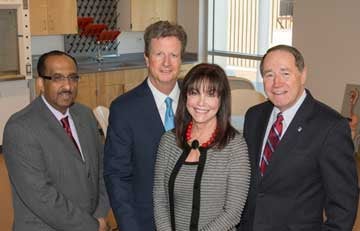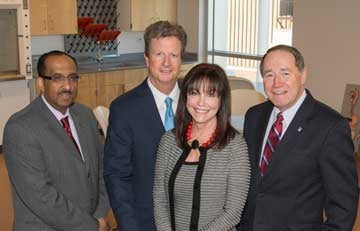 KINGSTON, R.I. – November 14, 2013 – With the largest private donation in its history, the University of Rhode Island will establish a neuroscience research institute named for the parents of Thomas M. Ryan, a 1975 pharmacy graduate of the University and former chairman, president and CEO of CVS Caremark. Tom and his wife Cathy have donated $15 million to establish the George & Anne Ryan Institute for Neuroscience at the University of Rhode Island.
KINGSTON, R.I. – November 14, 2013 – With the largest private donation in its history, the University of Rhode Island will establish a neuroscience research institute named for the parents of Thomas M. Ryan, a 1975 pharmacy graduate of the University and former chairman, president and CEO of CVS Caremark. Tom and his wife Cathy have donated $15 million to establish the George & Anne Ryan Institute for Neuroscience at the University of Rhode Island.
“The Ryan Institute will elevate the visibility of the groundbreaking research taking place here in Rhode Island and position URI as a leader in neuroscience research and the treatment of neurodegenerative and neurological diseases,” said URI President David M. Dooley. “We are tremendously grateful to Tom and Cathy Ryan and the Ryan family for their foresight and continued generosity. They have created an enduring legacy and made a truly transformational gift.”
“When I retired from CVS two years ago,” said Ryan, “we had conversations about what the family foundation would focus on and we decided to focus on education and health care. I had some discussions with President Dooley because, although I had given back to the University, I wanted to give to something that was more transformational, more lasting, really a future gift.”
The Ryan Institute will focus its research, teaching, and outreach on neurodegenerative diseases and disorders, like Alzheimer’s, Parkinson’s and ALS. It will draw on the expertise of more than 30 scientists from across the University who have been studying brain disorders and diseases from multiple perspectives and disciplines. The faculty – from pharmacy, engineering, psychology, chemistry, communicative disorders and more – participate in the University’s Interdisciplinary Neuroscience Program, established in 2011 to conduct innovative neuroscience research and offer master’s and doctoral degrees.
The Ryan Institute will be a magnet to attract people and engage them in solving some of the most pressing health care challenges we face in society – neurodegenerative diseases. This gift enables the University to attract leading researchers and train new generations of scientists to work on these problems. The Institute will collaborate with other state, regional and national entities to develop and deliver treatments for central nervous system disorders.
The University has unique research strengths in pharmacology/drug discovery, neuroengineering, and neuropsychology. To maximize statewide efforts in neuroscience, the Ryan Institute will stimulate cooperation among other institutions in Rhode Island, including the well-established neuroscience program at Brown University, the basic research programs of the Brown Institute for Brain Science, the newly formed Norman Prince Neurosciences Institute at Rhode Island Hospital that focuses on clinical neuroscience, and the U.S. Department of Veterans Affairs.
With more than 600 types of neurological disorders, the World Health Organization estimates that one in three Americans will suffer from a neurological disorder in their lifetime. Alzheimer’s disease alone cost the United States as much as $200 billion per year in direct and indirect health care expenses.
“When you look at what’s happening around the world with ALS, autism, epilepsy, Parkinson’s and Alzheimer’s, it’s truly an epidemic,” said Ryan. “As the population ages, not only in the U.S., but globally, it’s going to get worse.
“On a personal level, my dad retired at a young age, was extremely healthy, rock-solid, kind of bigger than life guy — and he had a stroke and then subsequent Alzheimer’s. I saw what it did to him, what it did to my mother, and our family. The economic costs are one thing, but the personal, emotional costs are another. It steals memories. It saddles caregivers. I saw my mom’s health go down. I had colleagues at CVS pass away from ALS. So it hit close to home for us and —once we did the due diligence and saw what was going on at URI —it was a natural fit.“
“In addition to helping ease the suffering of millions of people around the globe, the George & Anne Ryan Institute for Neuroscience will contribute significantly to economic development in Rhode Island by creating a vibrant environment for the expansion of basic biomedical research and clinical practice in neuroscience,” Governor Lincoln D. Chafee said.
Seeking new treatments and therapies for disorders of the nervous system are also among the top priorities of federal funding agencies.
“Neuroscience is one of the last scientific frontiers where fundamental discoveries can still be made,” said Nasser Zawia, a professor of pharmacology and toxicology, director of the University’s Interdisciplinary Neuroscience Program and dean of the Graduate School. “This investment could not have come at a more opportune time. Over the last decade or so there have been major advances in our understanding of the brain that have allowed for innovative therapeutic solutions and treatments not possible with our previous limited knowledge.”
This year, a national strategy to address these disorders was under discussion in Congress, the White House Office of Science and Technology Policy named its first coordinator of neuroscience research, the Obama administration unveiled a $100 million brain mapping initiative, and the Society for Neuroscience described the coming years as “a period of breakthrough discovery in brain science,” in which the field is “poised to make revolutionary advances.”
“A gift of this magnitude is truly historic for URI both in size and potential impact,” said Michael Smith, president of the URI Foundation. “This level of investment is truly transformational in nature in that it has the ability to make a significant impact, and to elevate and distinguish the important work being done in this area. This gift also makes an important statement about the Ryans’ faith in URI and its leadership, and about the affinity our alumni have for their alma mater. We are truly grateful.”
Ryan noted that, “If we do it right and we work together and we increase research dollars, get more faculty, more money in the state, find some cures, some breakthroughs, the economic development will follow. But, we’re not doing this for economic development, we’re doing this to try to solve a major problem in this country. And if we do that and do it better than anybody else, we will become the center of excellence, and I think that’s the ultimate goal.
“It’s just the right thing to do, and we think it’s going to make a difference; not only for URI, but for the state, and ultimately —for society.”
Shown above: URI President David Dooley (right) and Nasser Zawia (left), director of the URI Interdisciplinary Neuroscience Program, celebrate the establishment of the George & Anne Ryan Institute for Neuroscience with Tom and Cathy Ryan, whose gift of $15 million launched the Institute. URI Photo by Nora Lewis.
Neuroscience Facts
General Neuroscience:
• It is estimated that there are more than 600 types of neurological disorders, including Alzheimer’s disease, Parkinson’s disease, Down syndrome, epilepsy, dementia, mental illness, stroke and traumatic brain injury. (World Health Organization)
• Nearly 1 in 6 of the world’s population suffers from neurological disorders. (United Nations report)
• One in three Americans is estimated to suffer from a neurological or a neuropsychiatric disorder in their lifetime. (NIMH)
• Neurological disorders affect people in all countries regardless of age, gender, education or income. (WHO)
• An estimated 6.8 million people die every year as a result of neurological disorders. (WHO)
• Neurological conditions are the leading cause of disability in the world. (Movement for Hope.org)
Alzheimer’s Disease:
• Alzheimer’s disease alone costs our nation as much as $200 billion a year. (Alzheimer’s Association)
• Alzheimer’s disease is the 6th leading cause of death in the United States. (Alzheimer’s Association)
• More than 5 million Americans are living with Alzheimer’s disease. (Alzheimer’s Association)
• 1 in 3 seniors die with Alzheimer’s or another form of dementia. (Alzheimer’s Association)
• Today, an American develops Alzheimer’s disease every 68 seconds. In 2050, an American will develop the disease every 33 seconds. (Alzheimer’s Association)
• Alzheimer’s is the only cause of death among the top 10 in America without a way to prevent it, cure it or even slow its progression. (Alzheimer’s Association)
• An estimated 5.2 million Americans of all ages have Alzheimer’s disease in 2013. This includes an estimated 5 million people age 65 and older, and approximately 200,000 individuals younger than age 65 who have younger-onset Alzheimer’s. (Alzheimer’s Association)
• By 2025, the number of people age 65 and older with Alzheimer’s disease is estimated to reach 7.1 million – a 40% increase from the 5 million age 65 and older currently affected. (Alzheimer’s Association)
Parkinson’s Disease:
• As many as 1 million Americans live with Parkinson’s disease, which is more than the combined number of people diagnosed with multiple sclerosis, muscular dystrophy and Lou Gehrig’s disease. (Parkinson’s Disease Foundation)
• Approximately 60,000 Americans are diagnosed with Parkinson’s disease each year. (Parkinson’s Disease Foundation)
• An estimated 7 – 10 million people worldwide are living with Parkinson’s disease. (Parkinson’s Disease Foundation)
• Men are slightly more likely to have Parkinson’s than women. (Parkinson’s Disease Foundation)
• Parkinson’s disease affects one in 100 people over age 60. (The Michael J. Fox Foundation)
• Estimates show that 1 million people in the United States, and five million around the world have Parkinson’s Disease. (The Michael J. Fox Foundation)
Epilepsy:
• 1 in 26 Americans will develop epilepsy in their lifetime. (CURE Epilepsy)
• An estimated 3 million Americans and 65 million people worldwide currently live with epilepsy. (CURE Epilepsy)
• Each year, at least 200,000 people are diagnosed with epilepsy. (CURE Epilepsy)
• In 2/3 of patients diagnosed with epilepsy, the cause is unknown. (CURE Epilepsy)
• Epilepsy affects more people than multiple sclerosis, cerebral palsy, muscular dystrophy and Parkinson’s combined – yet receives fewer federal dollars per patient than each of these. (CURE Epilepsy)
• It is estimated that up to 50,000 deaths occur annually in the U.S. from status epilepticus (prolonged seizures), Sudden Unexpected Death in Epilepsy, and other seizure-related causes such as drowning and other accidents. (CURE Epilepsy)
• Sudden Unexpected Death in Epilepsy (SUDEP) accounts for 34% of all sudden deaths in children. (CURE Epilepsy)
• 2.2 million troops have served in current Iraq and Afghanistan conflicts; it is estimated that 440,000 of these soldiers will experience traumatic brain injury and more than 100,000 of these soldiers are expected to develop post-traumatic epilepsy. (CURE Epilepsy)
• Epilepsy costs the United States approximately $15.5 billion each year. (CURE Epilepsy)
• About 150,000 new cases of epilepsy will be diagnosed in the United States each year. (CDC)
Amyotrophic Lateral Sclerosis (ALS):
• It is estimated that ALS is responsible for nearly two deaths per hundred thousand population annually. (ALS Association)
• Approximately 5,600 people in the U.S are diagnosed with ALS each year. (ALS Association)
• It is estimated as many as 30,000 Americans may have the disease at any given time. (ALS Association)
• Although the life expectancy of an ALS patient averages about two to five years from the time of diagnosis, this disease is variable and many people live with quality for five years or more. More than half of all patients live more than three years after diagnosis. (ALS Association)
• About 20% of people with ALS live five years or more, and up to 10% will survive more than 10 years and 5% will live 20 years. There are people in whom ALS has stopped progressing and a small number of people in whom the symptoms of ALS reversed. (ALS Association)
• ALS occurs throughout the world with no racial, ethnic or socioeconomic boundaries. (ALS Association)
• ALS can strike anyone. (ALS Association)

